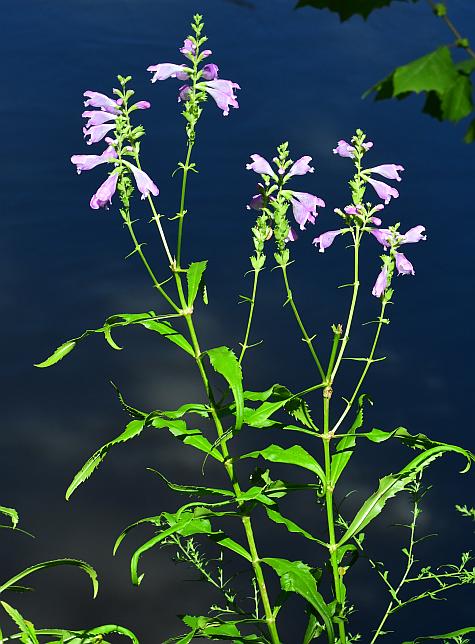Physostegia virginiana (L.) Benth.
Obedient Plant, False Dragonhead

Native
CC = Amb
CW = -3
MOC = 69
© SRTurner
Physostegia virginiana (L.) Benth.Obedient Plant, False Dragonhead | |
 |
Native CC = Amb CW = -3 MOC = 69 |
© SRTurner |
|
Family - Lamiaceae Habit - Perennial forb with a vertical rootstock and often slender rhizomes. Stems - Ascending to erect, to 1.5 m, 4-angled, glabrous, hollow, multiple from base, usually unbranched below the inflorescence, with 10-34 nodes below the inflorescence, often forming aerial roots near ground level.
Leaves - Opposite, simple, sessile, glabrous, progressively shorter toward the stem tip, the foliage leaves grading into the inflorescence bracts. Blades of main foliage leaves 2-18 cm long, 10-40 mm wide, lanceolate to oblanceolate, those of the lowermost leaves sometimes narrowly ovate, those of the median and upper leaves sometimes linear, sometimes with small basal auricles that clasp the stem, more commonly angled to a truncate or abruptly rounded base as wide as or slightly wider than the stem node, the margins sharply but sometimes finely toothed, sometimes mainly toward the blade tip. Lowermost leaves sometimes petiolate but usually withered at flowering.
Inflorescences - Dense, elongate, bracteate, terminal racemes. Axis of inflorescence densely pubescent with minute hairs. Bracts 2-8 mm long (except sometimes the empty basal bracts longer), mostly shorter than the calyces at flowering, lanceolate to ovate. Flowers sessile or with a short pedicel.
Flowers - Calyces mostly somewhat overlapping along the inflorescence axis, 3-9 mm long at flowering, becoming enlarged to 4-11 mm at fruiting, the outer surface densely pubescent with very minute hairs. Corolla bilabiate, 8-35 mm long, pale to deep pink, pubescent externally. Corolla tube to 2.3 cm long, constricted at base where surrounded by calyx, expanded beyond calyx. Upper lip 8-9 mm long, 7-8 mm broad, truncate to rounded at apex, the sides parallel. Lower lip 3-lobed. Lateral lobes 3-4 mm long, 3 mm broad. Central lobe 5-6 mm long, 4-5 mm broad, with purple spotting internally. Stamens 4, didynamous, ascending under the upper lip of the corolla. Filaments adnate for most of length, white or tinged with pink. Anthers purplish-brown, 1.7 mm long. Style inserted between stamens (and slightly longer), white, glabrous, 2.5 cm long. Stigma 2-lobed, filiform. Ovary 4-parted, green, glabrous.
Fruits - Dry schizocarps, separating into usually 4 nutlets, these 2-4 mm long, ovoid to broadly ellipsoid, angled at the tip, 3-angled, the angles often ridged, the surface brown, glabrous, finely pebbled or smooth.
Flowering - May - October. Habitat - Glades, prairies, savannas, tops of bluffs, streambanks, forests, swamps, acid seeps, fens, fields, ditches, railroads, roadsides, disturbed areas. Also cultivated. Origin - Native to the U.S. Lookalikes - P. angustifolia, P. intermedia. Differentiation can be very difficult. Somewhat resembles Chelone obliqua and species of Penstemon. Other info. - This popular species is found across Missouri, and throughout most of the eastern half of the U.S. and Canada. It is recognized by its dense spikes of flowers, which can range in color from deep pink to nearly white, and its sharply toothed, opposite leaves. It has an interesting indifference to moisture levels, being found in habitats ranging from swamp to glade. It is somewhat less tolerance of disturbance, with a CC value of 5 or 7 (dependent on subspecies). Two subspecies are recognized in Missouri. The plants are highly variable morphologically, showing extensive intergradation of characters, and identities are sometimes further obscured by interbreeding with horticultural forms. Differentiation of species and subspecies can be difficult. Photographs taken at the Bethel Prairie Conservation Area, MO., 7-4-03 and off Hwy 80, Montgomery County, AL., 6-4-05 (DETenaglia); also at Weldon Spring Conservation Area, St. Charles County, MO, 6-16-2007 and 8-1-2014; Dresser Island Conservation Area, St. Charles County, MO, 8-13-2012; Tyson County Park, St. Louis County, MO, 9-8-2021; and Riverfront Park, Washington, Franklin County, MO, 8-30-2024 (SRTurner). |